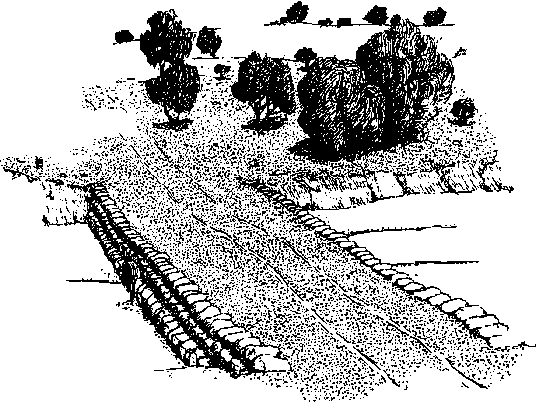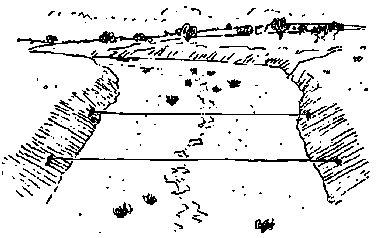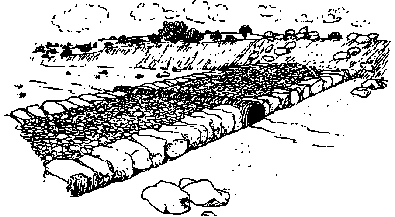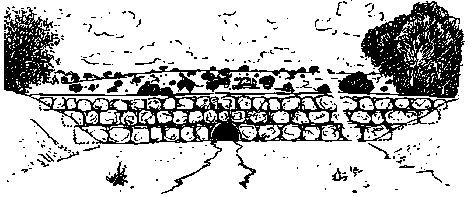How to Build Causeways out of Dry Stone
Contents
Dry Stone Causeways - Technical Brief
Short Description
- Problem:
- Idea:
- Difficulty:
- Price Range:
- Material Needeed:
- Geographic Area:
- Competencies:
- How Many people?
- How Long does it take?
While access to means of transport is inevitably a problem for poor people in the South, the lack of transport infrastructure can also isolate a rural area completely. Richard Tufnell demonstrates an inexpensive way to overcome a common problem using local materials

Figure 1: An inexpensive and strong method of providing access at all times of the year: a dry stone causeway
In many parts of the world, where heavy seasonal rains occur, access and transport problems can arise in remote rural regions during the rainy season. In these areas the most common type of road is made of dirt, and these range from good government-maintained roads to tracks where more or less the only form of maintenance is the clearance of stones to one side. Many villages and homesteads are served only by these smaller, locally constructed tracks, and as they do not have bridges they are impassable by vehicles and pedestrians during the wettest periods, causing great hardship. Children are unable to attend school and supplies cannot be brought in. Some local bus companies will not provide a service at any time if they cannot use a route all the year round, so these remote communities feel even more isolated. It is also much more difficult for local people to obtain jobs if they have no regular form of transport to use, and such regular necessities as shopping are made long and difficult.
People are very aware that bridges can solve these problems, but normal bridges are very expensive and money is rarely available. Efforts are often made to make a line of stones so that people can at least cross on foot without becoming wet or muddy, but such is the force of the water at certain times of the year that these are invariably washed away. It would seem that little can be done, but in fact there is a very inexpensive and very strong method of providing access at all times of the year, and that is a dry stone causeway.
A causeway is very like a bridge and serves exactly the same purpose, with one exception: it is designed so that it can be submerged under water during very heavy rains. A concrete version of this is known as a 'low bridge’, and examples can be seen in many parts of Africa. But building a causeway with dry stone - in other words without using any form of cement or concrete - has several major advantages.
First, it is inexpensive. The only cost is for some sections of drainpipe and possibly the hire of a tractor and trailer, small lorry or other means of transport for a few days. Often these items can be obtained from a local NGO or other community organisation. All the material in other words the stone is free and removing many tonnes for the causeway can make the surrounding land much easier to cultivate.
Secondly, although some skill is required and an understanding of the principles and how to build it is necessary, it is something that can be quickly learned. Indeed, careful reading of this article should enable anybody to organise the building of a causeway.
Thirdly, causeways can be built very quickly. Providing enough of the community take part, most causeways take only four or five days to build.
Equipment
|
Safety Injuries are rare when working with dry stone techniques, but there are one or two things that should be borne in mind when building a causeway. Some of the stones will be very heavy, and these boulders should be handled with care and common sense. Do not try to lift a heavy stone unaided - get help. Make sure fingers are not trapped, and heavy stones are not accidentally rolled or dropped onto the feet. During the filling process, when stones are thrown or dropped to the centre for packing, there is a tendency for some to bounce up. Make sure no one is in the way. Also take care when breaking or shaping stones with hammers, for small pieces can fly off at high speed and bruise or cut somebody. The eyes must be protected against these chips - blink or turn the head away at the moment the hammer strikes the stone, and wear eye protection if possible. |
The tools required are both simple and inexpensive. Most, if not all, will already be owned by members of the community, or could possibly be borrowed. The following is a guide to the total equipment likely to be required - not what each person needs.
For measuring and marking, there should be enough strong string to make up two lengths that are as wide as the causeway, for example if the causeway is 18 metres wide, then you will need two 18-metre lengths. You will need four short 'pegs' to drive into the ground to tether the strings. Metal pegs can be hammered into the ground safely without breaking, but wood will do if metal cannot be obtained. A spirit level is necessary to ensure that the finish is level, although if this really cannot be obtained, another method for levelling is described later. A tape measure at least seven metres long is useful, but not essential.
For digging earth (which is required at the end) and moving earth and stone, there should be three or four pickaxes and a similar number of shovels. Three or four wheelbarrows will be needed. A metal bar helps to prise boulders out of the ground, and to move them into position in the causeway. A strong sack or two will make it much easier to lift very heavy stones onto whatever means of transport is available. (While the stones can be carried or rolled down to the site, this involves a great deal of extra effort, and a tractor or lorry, if available, is extremely useful. Other means of transport, such as trailers or carts, could also be used, and if the supply of stone is a little way away from the causeway, then some form of transport is essential.)
A drain has to be made through the centre of the causeway to deal with low volumes of water and to prevent the causeway silting up. This is formed by using corrugated metal half-sections, which are joined together during construction. Thirteen or fourteen of these are required, and will need to have a diameter (width at the widest point) of 60 to 70cm.
Organisation is important, because a large number of people need to get together during construction. First, it may be necessary to get permission from the government or from the local community leader. Next, it is important that the community elders or council hold a meeting to explain what is proposed, and to make sure enough people are willing to help with the work. To build a causeway in a week or less takes a hundred or more people - the more the better - and it is important that this is understood. Although it is possible to build with fewer people, it is not practical.
It is also important that each of the two main groups, namely the stone gatherers and the builders, have a 'headman', so that everybody knows what to do and works efficiently.
If possible, the site of the causeway should be on a rocky part of the bed of the river or watercourse. It is probable that the site cannot be 'chosen', for there will already be a track leading to it, and this will be where people need to cross. There may also be an alternative route close by, even if there is a main track already in existence. If the existing site is across an earthy part of the riverbed, and if there is a rocky area close by that can be used without too much difficulty, then choose this second option. The reason for this is that you will not need to take extra precautions against erosion when building on a natural rock foundation.
Collecting stone
You will need a good deal of stone, between 150 and 200 tonnes for the average causeway. This needs to be of three basic sizes. First, the sides of the causeway are built with large boulders. The heavier these are the better, and the smallest should be very difficult for a strong man to lift. Secondly, the centre of the causeway - everything except the sides - is filled with stone of all types, but which are reasonably easy to lift and carry. These stones will range from the size of a football to the size of an orange, and can be of any shape. Finally, small stones - fist-sized and smaller -are used to level off each of the three layers in the structure.
Everyone who is helping should be organised into groups to collect the stones. If the stones are very close by, they can be carried to the site, otherwise they can be gathered into heaps beside a track where they can be loaded onto transport. A supply of large, heavy boulders is needed first, as these will be laid before anything else.
Marking out the site
The standard width of the causeway is seven metres, or seven large paces. This may seem large, but much stone will have to be used, making the structure massive and resistant to damage during flooding. It also enables all vehicles to cross safely, including lorries and buses.
Having chosen the site, check exactly where the lines of the causeway are to be. This should be fairly obvious if it has been used as the crossing point for a path or track already.
The first strings need to be some 30cm off the riverbed, and level. Drive in a peg at each end and attach the string (see Figure 2).
The lowest part of the riverbed - which is where the drain will be placed -will probably be about half way along the string, as in the diagram. Use the spirit level to ensure that the string is horizontal. If you do not have a spirit level, then use a section of hosepipe to check it. This is done with two people, who hold the hosepipe in the approximate position the pegs will be in. Fill the hose with water. Water always finds its own level, so one or both ends can be moved up or down until the water just comes to the top of each end of the pipe. This procedure is easier if something like a clear plastic funnel is pushed into each end; you can then see the water more easily.
Now measure seven metres from each peg. Either use a tape measure, or place one foot directly in front of the other (heel touching toe) until 21 footsteps have been taken. Drive in the remaining two pegs, and again attach a string. Now the two strings must also be checked for being level with each other. Using one of the above methods, compare the string levels at each end.
This procedure is simpler than it may sound, and it is very important. Take your time and double check every action. It is much better to spend an extra ten or twenty minutes at this stage than have a causeway that is not built correctly. Once the strings are satisfactorily attached, the building can begin.
Building
There should be a good supply of large boulders dumped close to the strings, and these are now manoeuvred into place along the line of the string. Starting at one end, position a boulder so that the top of the boulder is the same height as the string, and as close to it as possible without actually touching. Most boulders are unevenly shaped, and will need to be 'pinned' with wedges of stone driven beneath them. These wedges need to be tapered or pointed; square or round stone are not good because they can fall out far too easily (see Figure 3).
Once the first boulder is in position and securely pinned, place another beside it in exactly the same way. There is a very important rule to be followed at this point, and that is that every boulder must touch the one beside it. Never leave gaps between the boulders. When the second boulder has been positioned and pinned, push more pins into any space left between them.
Continue laying boulders along the string, leaving a gap of one to one-and-a-half metres in the middle for the drain sections. Boulders must then be laid along the second string in exactly the same way, again leaving a gap in the middle for the drain.
Once the two lines of boulders are in place, remove the string. Now take the drain sections and, starting from one side, place them one after the other across the causeway. The first one must stick out a few centimetres, and each one after that must overlap a little - say by 20 centimetres or so. This locks them together. They must also be level, and so it may be necessary to pickaxe any obstructions out of the way (see Figure 4).
Once the drain is in, finish the layer by placing boulders to lock the drain in place. Now the centre of the causeway is filled up with stone. In fact, the centre can be filled as the boulders are laid if you wish, providing the stone coming in does not interfere with other building operations. The stone that fills the causeway should go up to, but not above, the boulders that have been laid; in other words once this part is finished, there should be an even, level layer.
Now the strings are repositioned. They are raised by about 30 centimetres, and they must also be moved in towards the centre by 30 centimetres. This means that the next layer is narrower than the one below. Now repeat the procedure as for the first level. Boulders are laid in one by one, touching each other and pinned securely into place. On this level, there is no need to leave a gap - simply continue across the drain section. There is one new point that must be followed for this layer, however, and that is that as far as possible, try and do what is known as 'breaking the joints'. This means that each boulder should sit on two below, just as when laying bricks or concrete blocks (see Figure 5).
In order to keep the boulders the same height as the string, some will need to be a little larger, others a little smaller. If the boulder is not tall enough to reach the string, try turning it on its side and pinning it that way. With the two lines of boulders set in, fill the centre again. Now you will have two level layers, and it will be time to raise the string again for the third and final time. Follow exactly the same procedure as for the second layer. Raise the strings by 30 centimetres and move them in by the same amount. If anything, it is even more important that they are level. It is very important that this final layer uses boulders that are just as big as the first two layers, because this is the layer that has to resist the floods most. If the approach to the causeway is gentle, it may be a good idea to cut away the banking at the ends so that larger boulders can be used all the way along, as in Figure 6 below. Place the line of boulders along each string, and fill up the centre until the causeway is flat. Do not let the surface 'dip' between the boulders; if anything, the centre should be a few centimetres higher than the edges. The final 15 centimetres or so should be small stones and chippings; they fill the spaces, bind the stones together better, and make for a smoother crossing either on foot or by vehicle (see Figure 7).
Finally, the surface of the causeway is 'blinded' with a layer of earth and subsoil. This should be about 15 centimetres thick. The approach to the causeway is often quite steep, and this provides an excellent opportunity for doing two jobs at once. By removing soil from the banks of the watercourse, the approach is made much shallower, and hence easier for traffic to use, especially in the rainy season. This soil then makes a good smooth surface for crossing the causeway. The earth will bind with the top layer of small stones to give a surprisingly strong finish.
If the causeway has to be built on an earth base, then measures will have to be taken to pre- vent erosion on the downstream side. A mixture of large and small stones should be built at an angle against the side of the causeway, to further break up the force of the water.
There is one more job to do before the finish, and that is to check every boulder on both sides, to see that they are touching. If a gap is found, then a thin slice of stone must be driven down hard between them with a hammer to lock them together. Once this is done, the causeway is finished, and it is immediately ready for use.
Reasons for design
It has already been explained why the causeway should be built to a good width. This makes it extremely heavy, and resistant to damage by floods. What other factors are involved?
The stepped design guides the water over the causeway smoothly, instead of acting as a dam. On the downstream side, the water does not fall straight down, but it flows gently, helping to prevent erosion.
Because the boulders are touching each other and locking together, the force of the water cannot move individual stones. The causeway is locked together as one unit, weighing perhaps 200 tonnes.
The action of the water is also reduced in other ways. A percentage will flow through the large drain section, and more will trickle through the causeway itself. The drain also prevents siltation. The causeway must be level because then the flow of water is spread evenly all the way along it. If the causeway slopes one way or the other, the force of the floodwater will concentrate at the lowest point and the possibility of damage will increase markedly.
It does not help to cement or concrete the boulders into place. It is expensive, and if the causeway is damaged during severe flooding, then large slabs will be removed rather than one or two boulders, and concreted stones cannot be re-used.
Although a great deal of labour is required, it is only for a short time, and then all the advantages of a dry crossing for traffic can be enjoyed by everyone in the community. The causeway is unlikely to be entirely maintenance free, and it is important that this is understood. With particularly heavy flooding, some of the stones may be moved, although not necessarily so. If this happens it is most important that the causeway is repaired the moment the water recedes enough to permit working. There needs to be immediate action by the community elders to organise the repairs, because there is a tendency for such matters to be ignored. Repairs have to be done before further flooding, for the next time the damage could be severe. Provided this precaution if followed, the causeway will give a great many years of service, and will stand as a tribute to the organisation and efforts of the people who built it.
Richard Tufnell is the International Coordinator of the Dry Stone Walling Association of Great Britain. He has written a number of booklets and produced training videos about stone walling.
For further advice contact him at DWSA GB, YFC Centre, National Agricultural Centre, Kenilworth, Warwickshire, CV8 2LG, UK. Fax: +441644430555. All drawings in this article are by Bill Holmes.
References and further reading
This Howtopedia entry was derived from the Practical Action Technical Brief Dry Stone Causeways - Technical Brief.
To look at the original document follow this link: http://www.practicalaction.org/?id=technical_briefs
Useful addresses
Practical Action
The Schumacher Centre for Technology & Development, Bourton on Dunsmore, RUGBY, CV23 9QZ, United Kingdom.
Tel.: +44 (0) 1926 634400, Fax: +44 (0) 1926 634401
e-mail: practicalaction@practicalaction.org.uk
web: www.practicalaction.org

Related articles
- How to Fight Soil Erosion by planting Vetiver Grass
- How to Fight Soil Erosion
- How to Stop Gullies on Eroded Slopes
- How to Build Causeways out of Dry Stone
- How to Harvest Rainwater
- How to Harvest Run Off Rainwater
- How to Start Culture in Zai Holes
- How to Control Water Hyacinth
- How to Recycle Rubber





